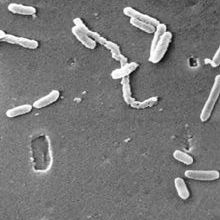CSIC and UAM scientists redefine the limits of microbial life after discovering bacteria that survive in heavy water without nutrients for over 30 years
29 May 2025

- These "extremophile" bacteria have managed to adapt and thrive in extremely pure heavy water, a very hostile environment for most known life forms.
- The discovery, published in Microbial Genomics, opens new perspectives in biotechnology, plastic degradation, and could aid the search for life in extreme environments in the solar system.
In a discovery that redefines the known limits of microbial life, a team led by the Centro de Biología Molecular Severo Ochoa (CBM-CSIC-UAM), Spain, has shown for the first time that certain bacterial communities can not only survive but adapt and proliferate in extremely pure heavy water, an environment considered hostile to most known life forms.
The study, published in Microbial Genomics, involved researchers from the Universidad Autónoma de Madrid (UAM), the Centro Nacional de Biotecnología (CNB-CSIC), Spain, the Instituto de Ciencia y Tecnología de Polímeros (ICTP-CSIC), Spain, the Canfranc Underground Laboratory (LSC), Spain, and the Eberhard Karls University of Tübingen, Germany.
The work describes the discovery of millions of bacteria per milliliter in heavy water stored in hermetically sealed plastic jugs for more than 30 years at the Department of Materials Physics at UAM’s Faculty of Sciences. These bacteria evolved in a nutrient-free environment containing chemically stable bonds that are toxic to most organisms.
Normal water is made up of two hydrogen atoms and one oxygen atom (H₂O). In heavy water, deuterium replaces hydrogen (D₂O), forming more stable bonds and altering the chemical reactions inside cells: it slows down essential metabolic reactions, interferes with energy production, and can destabilize DNA and proteins. When a large portion of an organism's body water is replaced with heavy water, many cellular functions fail. Therefore, finding not just living but active bacteria in this medium is an unprecedented discovery.
"Deuterium is an extremely rare hydrogen isotope in the universe. On Earth, only 1 in every 5,700 hydrogen atoms is deuterium. We know of no natural environments with such a high concentration as in our samples, making them a unique opportunity to study a different type of adaptation. Seeing the metabolic complexity of these bacterial communities was astonishing," explains Juan Rivas, study author and researcher at CNB.
A toxic environment turned into a microbial habitat
Using metagenomic analysis and massive DNA sequencing (techniques that allow the reading of all the microorganisms’ DNA in a sample without culturing), researchers identified bacterial communities mostly belonging to the Pseudomonadota and Bacteroidota phyla. These include highly versatile and resilient bacteria capable of surviving in extreme conditions, such as contaminated soils or nutrient-poor areas, which could explain their survival in such a hostile environment as pure heavy water.
The bacteria found in the heavy water exhibit unique genetic traits: shorter genes and proteins optimized to minimise energy expenditure in an environment lacking accessible carbon sources, except potentially from the degradation of the plastic (HDPE) containers.
“Finding genes related to polyethylene degradation suggests these bacteria might be using the container itself as a carbon source. This opens fascinating avenues for biotechnology, especially in terms of recycling resistant plastics,” highlights Francisco Sobrino, lab head at CBM.
Another notable finding is the abundance of genes related to DNA repair and recombination mechanisms, reinforcing the hypothesis that these bacteria have developed original molecular strategies to survive in an environment that compromises genetic integrity.
Implications for biotechnology, sustainability, and astrobiology
“This work not only expands our knowledge of bacterial adaptability, but also has direct implications for the search for life in extreme environments, both on Earth and beyond. The 'deuterosphere' we describe —a microenvironment highly enriched in deuterium— is a unique model to explore the boundaries of life,” says Ricardo Amils, CBM microbiologist and study co-director.
Just like the Rio Tinto (Huelva), an extreme and highly acidic environment, has been used as a terrestrial analog of Mars, this new study demonstrates that microorganisms can adapt to conditions previously considered incompatible with life—strengthening the idea that life could exist elsewhere in the solar system.
As part of the project, experiments are underway at the Canfranc Underground Laboratory (LSC) to study how the presence or absence of secondary cosmic radiation—such as muons, neutrons, and gamma rays—affects the viability and evolution of these bacteria.
The LSC allows researchers to simulate underground conditions similar to those on Mars or moons like Enceladus or Europa, where life—if it exists—would be protected from radiation in icy or aquatic subsurfaces.
Although heavy water has not been detected in large quantities on any planet or moon in the solar system, space probe measurements show that some comets, Venus, and the moons Europa and Enceladus have higher deuterium ratios than Earth. This suggests that microenvironments with chemical conditions similar to the experiment could exist, reinforcing the usefulness of the “deuterosphere” model for exploring how life might adapt on other worlds.
This pioneering discovery not only broadens our understanding of life’s limits on Earth, but also suggests new possibilities for environmental biotechnology and astrobiological exploration, paving the way for applications in plastic degradation and identifying new metabolic pathways in extreme conditions, such as those artificially created in nuclear reactors.
Image caption: This scanning electron microscopic (SEM) image depicts a number of Gram-negative, Pseudomonas aeruginosa, rod-shaped bacteria.
NOTES FOR EDITORS
The paper "Metagenomic Analysis of Heavy Water Adapted Bacterial Communities" by Juan Rivas-Santisteban, José M. Martínez, Cristina Escudero, Rebecca Hernández-Antolín, Laura Cid-Barrio, Gary J. Ellis, Esteban Domingo, Carlos Sánchez, Francisco Sobrino and Ricardo Amils is avalible in Microbial Genomics at the following:
DOI: https://doi.org/10.1099/mgen.0.001414
URL: https://www.microbiologyresearch.org/content/journal/mgen/10.1099/mgen.0.001414
Contact
[email protected]
Image: CDC/Janice Haney Carr.
